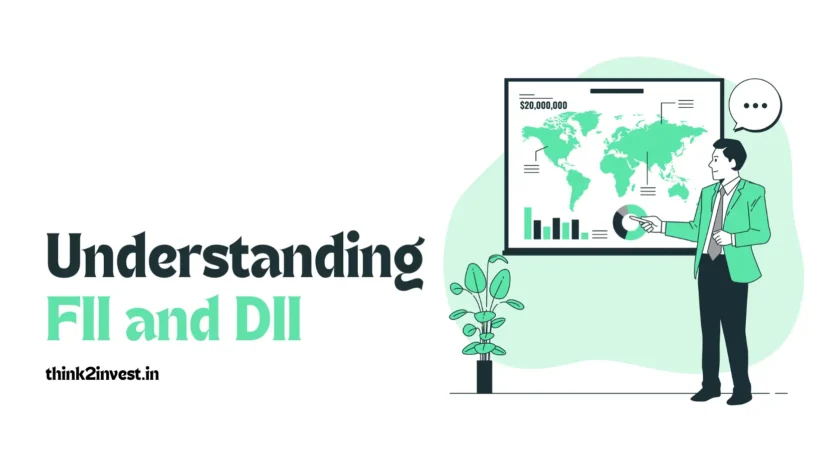Understanding FII and DII
When you hear that the stock market is rising or falling, it often has a lot to do with what large investors are doing. Among the biggest players are FIIs (Foreign Institutional Investors) and DIIs (Domestic Institutional Investors). Understanding how they operate and how their actions affect the market can help you become a smarter investor.
What is an FII?
FII stands for Foreign Institutional Investor. These are entities such as investment banks, hedge funds, mutual funds, insurance companies, or pension funds based outside a country, which invest in that country’s financial markets.
Simple Example:
Imagine a large U.S.-based mutual fund like Vanguard decides to invest $100 million in Indian stocks such as Infosys or HDFC Bank. That activity makes Vanguard a FII in India.
Key Characteristics:
- They bring foreign capital into the domestic market.
- Their investments are often large, impacting market trends.
- Their moves are closely monitored as they can influence investor sentiment and stock prices.
What is a DII?
DII stands for Domestic Institutional Investor. These are institutions within the home country that invest in its own financial markets.
Simple Example:
If LIC (Life Insurance Corporation of India) invests ₹500 crore in Indian companies like Tata Motors or ITC, it’s acting as a DII.
Key Characteristics:
- Include mutual funds, insurance companies, banks, and pension funds.
- Their investments often reflect domestic sentiment.
- DIIs tend to have a stabilizing effect on the market, especially when FIIs withdraw funds.
FII vs DII: A Quick Comparison
| Feature | FII | DII |
|---|---|---|
| Origin | Foreign | Domestic |
| Examples | BlackRock, Vanguard | LIC, SBI Mutual Fund |
| Currency | USD/Other | INR |
| Influence | High due to foreign capital | Stabilizing, long-term |
Why Are FIIs and DIIs Important?
These investors bring large volumes of money into the market. Their activity is one of the most significant indicators of market direction.
- When FIIs buy, it usually causes stock prices to rise.
- When they sell, markets can dip.
- DIIs often buy when FIIs sell, and vice versa, helping maintain balance.
📌 Interesting Facts About FIIs and DIIs (Made Simple!)

📈 1. FIIs own a big piece of Indian stocks
Foreign investors (FIIs) hold a lot of shares in big Indian companies like Infosys and HDFC Bank—sometimes more than 30%. That’s why their buying or selling can really move the stock market.
🌍 2. FIIs follow global news
If the U.S. raises interest rates or there’s a war or oil price jump, FIIs often pull their money out of countries like India. They follow the global money flow.
🔁 3. FIIs and DIIs often do the opposite
When FIIs are selling, DIIs (like LIC or Indian mutual funds) are often buying—and the other way around. This helps balance the market and avoid big crashes.
💰 4. DIIs are growing stronger
More Indian people are investing through mutual funds and SIPs (Systematic Investment Plans). This gives DIIs more money to invest, making them more powerful in the stock market.
✅ 5. FIIs are regulated
Foreign investors can’t just invest freely. They must register with SEBI (India’s market watchdog) and follow certain rules.
📊 6. FII money can start a bull market
When FIIs start investing heavily, the stock market often goes up for months or even years. This happened in 2003, 2014, and again after the COVID crash in 2020.
🏦 7. DIIs include more than just mutual funds
Big Indian funds like EPFO (retirement fund) and NPS (pension plan) now also invest in the stock market. That means even your retirement money could be helping support Indian stocks!
Where to Track FII & DII Activity
Monitoring Foreign Institutional Investors (FII) and Domestic Institutional Investors (DII) activity is essential for understanding market trends and sentiment. You can track daily FII/DII data on the following reliable websites:
-
Moneycontrol – FII/DII Activity
Get real-time data and historical trends on FII and DII investments across various sectors.
-
NSE India – Institutional Activity
NSE publishes daily updates on institutional trading data, offering insight into buy/sell activity.
-
Economic Times – Markets
Comprehensive market coverage, including updates on FII and DII actions and their impact.
Final Thoughts
Understanding the role of FIIs and DIIs gives you a deeper perspective on market movements. Their buying and selling patterns can act as a signal for broader trends. While retail investors (like you and me) may not have the same financial muscle, keeping an eye on institutional activity helps in making informed investment decisions.
Tip: Don’t just follow the trend blindly. Use FII/DII data as one of many tools to build your investment strategy.





